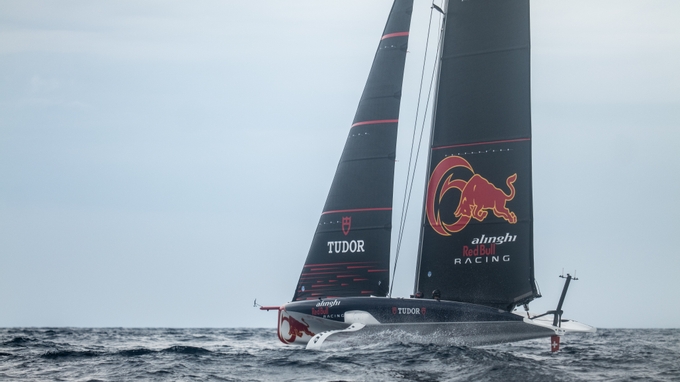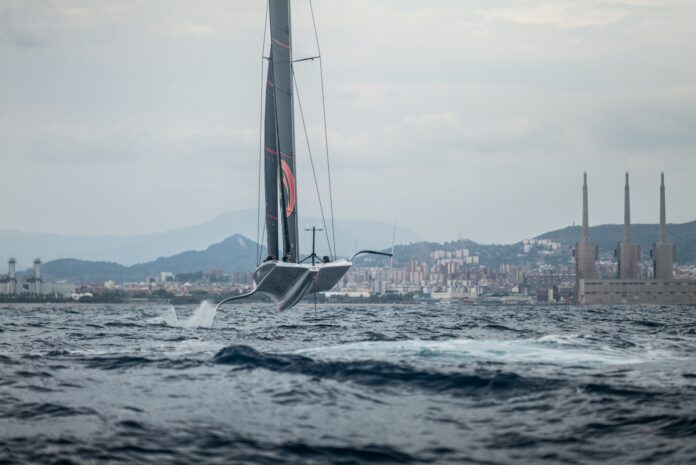It was October-like conditions in Barcelona on Thursday with a southeast ‘Xaoloc’ wind and an easterly swell sitting offset to each other producing challenging conditions for a commissioning day of Alinghi Red Bull Racing’s novel Tubercle port foil. The Swiss more than manned-up to the conditions, sending the AC40 (now firmly in LEQ12 mode) over some 50 nautical miles through five hours of solid testing with the sailors looking masterful as they pushed through the design office’s check list.
New products are appearing on an almost daily basis now with Alinghi Red Bull Racing and at launch, we saw the first in-house mainsail from sail designer Gautier Sargent’s sail loft being hoisted with some interesting panel work strengthening around the leech and luff. The M1 was lowered soon after to be replaced by the AC40 one-design mainsail but it was a glimpse of what we can expect from the Swiss in the very near future. Also debuted was a new J1 headsail, again a first build from the in-house sail loft.
On the water, the crew onboard the LEQ12 AC40 were led by Maxime Bachelin and Nicolas Charbonnier and pushed through long runs and slick manoeuvres with increasing intensity in tacks noted as the breeze built, and a stunning 96% success rate foil-to-foil was observed. The new foil looked stable through the mode changes and the team appeared more than comfortable with it. The recon team noted what could be hydrochromic ‘stripping’ paint on the new foil which leeches under load and gives the design team a clue on loading areas and flow – we also suspect this was on the new Emirates Team New Zealand LEQ12 starboard foil that we saw this week.

Speaking afterwards, the ever-present on-water design co-ordinator, Adolfo Carrau, summed up the day saying: “Today was a bit of a commissioning with it, was a bit of a fast commissioning, but we did first check that structurally and the mechanics of the foil were working as intended and then we had a long day just going through the settings – different boat speeds and cants and pitch – so, typical settings that you try on the foils just to see how it (the new port foil) behaves and comparing against the other foil (starboard one-design) which we know already much better. So, I think as a first day it was pretty successful.”
And Adolfo continued: “We were really lucky with the conditions because they were as challenging as it gets and that’s what we want to test with a new foil, just get it on the trickiest conditions and see how it goes and yeah it (the wind/sea state) was something which we saw last year which could happen, these sea-state conditions and we got exactly that.”

When asked a fascinating question about ventilation being much harder to predict than cavitation on the foils, Adolfo gave an insight into the new modelling that the teams are able to perform, saying: “The technology is improving and, in the past, cavitation was hard to predict then we managed to predict that pretty well now. The same is happening with ventilation, the tools are getting better and better and that’s what we’re trying to do in the water is really get the foil in different situations so then we can replicate with the tools and see how good we are predicting. That’s what you do with the AC40, really just validation, tool validation.”
Scaling up from the ‘LEQ12 AC40’ into the AC75 raceboat is going to be the key to success at AC37 in Barcelona and asked whether there would be any complications in that process, Adolfo gave a very simple answer that validates why so much work is going into these scaled-down test boats through this cycle: “No it’s going to be much simpler” and that encompasses sail design, foil design and in some cases, hull design.
Alinghi Red Bull Racing are in fast development now and the days and weeks ahead will be fascinating as they cycle through iterations and reveal more new technology. Everyone is watching the Swiss closely at the moment.

On-Water Recon Unit Notes: Alinghi Red Bull Racing rolled out their AC40-4 (the first AC40 delivered) at 08:45 and prepared the yacht at the dock ahead of a day of commissioning and testing. The bottom of the new foil seems like it could have been painted with hydrochromic paint. By observing the colour change of hydrochromic paint, they could better
understand the water flow around the foil, identifying areas of turbulence or smoother flow. It was also noticed the middle panel underneath the foil, was painted black, which during sailing peeled off towards the tips and under the bulb, as seen in the photos of the foil taken towards the end of the day.
The team docked out at 11:05 and hoisted their new M1-1 LE Mainsail to check the fit. With the limitations around AC75 sails, the team have revealed their first sail design, to be tested on the AC40, starting with trials of “different structure layouts”, according to Design Co-ordinator, Adolfo Carrau. A clear distinction between the luff and leech panels can be noticed. It appears that the head of the new M1 has a different profile.
The new mainsail was dropped and replaced with the OD mainsail, after which, an undeclared ‘J1-1 LE’ jib was hoisted. A slight difference can also be seen in the head,
with four tell tales below the upper stripe, compared to three tell tales on the OD jib.
Conditions for the day were similar to those recorded in October, with around 10 knots wind from the southeast and up to 1m swell from the east. Sailing commenced from
outside the port entrance at 12:35, with the team sailing along with the new foil in the water for commissioning. With a 45° offset between the wind and waves, upwind on starboard tack meant the port foil was travelling directly into the waves, while port tack upwind would have the yacht sailing side on to the waves.
The J1 was dropped for the J2-1 OD for the second stint as the wind started to slowly increase and turn towards the east south east. The team sailed upwind, putting in 11 fully foiling tacks, with tacking frequency progressively increasing. The third stint consisted of reaching, pre-start practice and upwind sailing about the 1.5NM two mark windward/leeward course, but a nosedive just after the windward mark rounding brought the stint to a close.
The team spent almost 5 hours on the water, covering over 53NM. A total of 43 manoeuvres were performed (88% fully foiling).
Dock-Out: 1105 Dock-In: 1555
Conditions: ‘Xaloc’ – South East Wind – 5-8kn SE @ 12:30, 8-10kn SE @ 14:10, 9-11kn ESE @ 15:20.
Weather AM: 16°C, Sunny.
Weather PM: 16°C, Sunny.
Sea State AM: Beaufort 2-3 – 0.7m-1m E Swell
Sea State PM: Beaufort 3 – 0.7m-1m E Swell
Onboard Today:
Driving Group: Maxime Bachelin / Nicolas Charbonnier
Flight Control: Nicolas Rolaz / Lucien Cujean
Additional Notes:
Starboard: Maxime Bachelin + Nicolas Rolaz, Port: Nicolas Charbonnier + Lucien Cujean.
Sails Used:
Mainsail M1 (M1-1): 3 hours 45 minutes
Jib J1 (J1-1 LE): 35 minutes
Jib J2 (J2-1 OD): 2 hours 40 minutes.
Total Tacks: 26 – 25 foil-to-foil, 1 touch & go, 0 touchdowns.
Total Gybes: 17 – 13 foil-to-foil, 1 touch & go, 0 touchdowns.
Recon Notes:
12:35 – 12:45 Sailing on Starboard – Commissioning new foil.
13:00 – 13:25 Sailing (11 Tacks – Fully Foiling)
13:30 – 14:10 Sailing (4 Tacks – Fully Foiling, 9 Gybes – Fully Foiling, 1 Gybe – Touch & Go, 1 Gybe – Touch Down)
14:25 – 15:10 Sailing (10 Tacks – Fully Foiling, 1 Tacks – Touch & Go, 3 Gybes – Fully Foiling, 1 Gybe – Touch Down)
15:20 – 15:40 Sailing (1 Gybe – Fully Foiling, 1 Gybe – Touch Down)

ALEX CARABI / AMERICA’S CUP

ALEX CARABI / AMERICA’S CUP

ALEX CARABI / AMERICA’S CUP



















